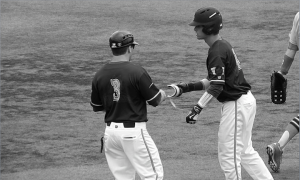The Value of the Stolen Base
Matt Talarico, Wright State Baseball/StealBases.com
Base stealing is a stat that is often questioned. Since sabermetrics have been popular the risk of stealing a base simply is not worth the reward. Why would you take the chance to move up 90’ and risk getting thrown out?
However, I believe base stealing matters. I can’t say I disagree with the concerning stats, but why can’t we work to make the risk lower?

What is the value of a stolen base?
Even the doubting statisticians admit that the “no doubt” situation requires trial (with the risk of error) because chances of scoring from second are higher than scoring from first. There were many situations this year alone where we scored on a bleeder that would have never scored us if we weren’t on second. In my college coaching experience I’ve been involved with many 1 run games where we would have killed for just one more run to either go ahead 2 or tie up a game. So from this perspective, a stolen base is very valuable. If you have great odds, take a shot.
Also, in baseball we do not measure the amount of pressure that is put on a defense when there is a legitimate base stealing threat. This amount of stress can cause so much to go wrong. We should measure not just the stolen base alone but add the times the runner moves up on a ball in the dirt, moves up to second from an error, or forces the pitcher to balk. These stats go unnoticed but create even more pressure on the pitcher and the other team. I would bet in my years where we stole 80 or more bases we also were one of the best teams in the conference in balks drawn or errors from the opposing pitcher or catcher. This only happens when we have established a base stealing threat and is not included in sabermetrics.
Check out the Brewers steal 4 in an inning. This is pressure.
We have to find a way to lower the risk. The goal is low risk, high reward base stealing.
To accomplish this you have to teach! Base stealing, for some reason, is a skill we just expect our players to know how to do if they are fast. Even if they can run they usually plateau by stealing a lot early on then stopping when people know who they are and give them a little attention. Great base stealers and base stealing teams have an answer. If the pitcher is quicker to the plate then the runner needs a tool to be quicker to second or third. If the runner only has one tool (to outrun the catcher’s pop time) then he just hopes the catcher is bad that day or gambles… I don’t like either option.
To be able to go to the appropriate tool without a coach telling you to do so is called feel. I try to teach feel. We do this by attacking from multiple angles:
- Teach the value of the stolen base – We can steal a lot of bases or steal zero bases and still have a great impact on the other team if we are a real threat.
- Studying video of previous players – There isn’t a better tool to educate than video of players succeeding and failing.
- Educating players by frequent communication – I have discussions with my players during practice, games, video sessions, text messages, etc.
- Meticulously work on technique in relaxed environments – It is important to get guys to work on technique without the fear of failing.
- Using the scrimmage format for education – We will break the flow of the game to make sure we use failing as a tool for rapid learning.
- Building confidence through knowledge – Our players believe they know more about stealing than the opposing pitcher or coach trying to stop them.
Through this philosophy I’ve developed through my coaching career we have had success with a wide variety of teams and base runners. I believe players at any level can be a legitimate threat without taking an unnecessary risk. Build the tool set and educate the runner and the result will be a great benefit to any offense. For more information, visit www.stealbases.com, and enter discount code “baseballplus” for $15 off.
